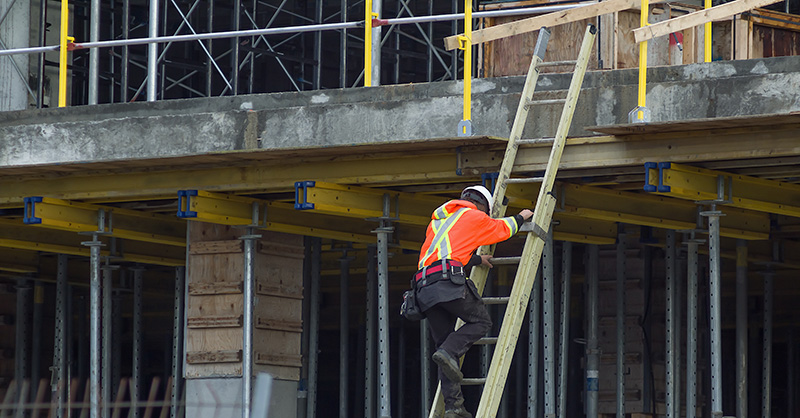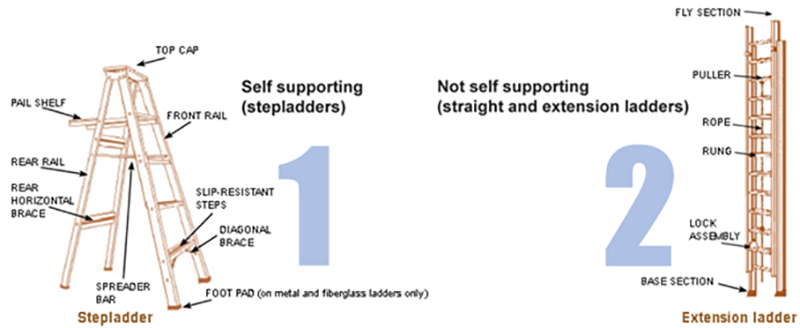Portable Ladder Safety in Construction

According to the Federal Occupational Safety & Health Administration (OSHA), falls are the leading cause of death in construction, with falls from ladders making up nearly a third of those deaths.
Falls from ladders can be prevented, and lives can be saved by following the safe work practices described below.
When Should You Use a Ladder?
When you want to reach a high work area, think about the best equipment to use. While a ladder or stepladder is commonly used, there may be better options. Ask yourself these questions before deciding on a ladder:
- Will I have to hold heavy items while on the ladder?
- Is the elevated area high enough that it would require a long ladder that can be unstable?
- Will I be working from that height for a long time?
- Do I have to stand on the ladder sideways to do the work?
If your answer is yes to one of the above questions, consider using something other than a ladder. If possible, bring in other equipment, such as a scissor lift. If you must use a ladder, use one that has a working platform with handrail barricades on the sides (e.g., a platform stepladder).
Types of Portable Ladders
There are generally two basic types of portable ladders, which differ based on how they are supported: self-supporting and non-self-supporting.

Self-Supporting Portable Ladders
Stepladder: A stepladder is a self-supporting portable ladder, nonadjustable in length, having flat steps and a hinged back. Its size is designated by the overall length of the ladder measured along the front edge of the side rails.
Non-Self-Supporting Portable Ladders
Extension Ladder: An extension ladder is a non-self-supporting portable ladder adjustable in length. It consists of two or more sections traveling in guides or brackets that permit length adjustment. Its size is designated by the sum of the lengths of the sections measured along the side rails.
Single/Straight Ladder: A single ladder is a non-self-supporting portable ladder, nonadjustable in length, consisting of one section. Its size is designated by the overall length of the side rail.
Common Ladder Materials and Design
Ladders can be made of metal, wood, reinforced plastic or fiberglass. The most common material is aluminum. Metal ladders should never be used for work on or around exposed electrical elements; a wood or fiberglass ladder is necessary. However, refer to warning labels on the ladder or the manufacturer’s directions because some nonmetal ladders are reinforced with steel or other conductive materials.
OSHA Portable Ladder Requirements
OSHA requires that portable ladders meet the design and construction requirements for the material of construction as follows:
| Portable Ladder Material | In Service After January 7, 2011 | In Service On or Before January 7, 2011 | Exception |
| Wood | American National Standards Institute (ANSI) A14.1-2007, American National Standard for Ladders - Wood Safety Requirements. | ANSI A14.1 standard in effect at the time such ladders were placed in service. | Portable job-made cleat ladders that are designed and constructed in accordance with the requirements of Section 1676 of the Construction Safety Orders |
| Metal | ANSI A14.2-2007, American National Standard for Ladders - Portable Metal - Safety Requirements. | Either the ANSI A14.2 standard or the ANSI A14.10 standard, American National Standard for Ladders - Portable Special Duty Ladders, in effect at the time such ladders were placed in service. | |
| Reinforced Plastic | ANSI A14.5-2007, American National Standard for Ladders - Portable Reinforced Plastic - Safety Requirements. | Either the ANSI A14.5 standard or the ANSI A14.10 standard in effect at the time such ladders were placed in service. |
Consult the following standards for ladder sizes and safety requirements established by ANSI:
- ANSI A14.1-1990 Safety Requirements for Portable Wood Ladders
- ANSI A14.2-1990 Safety Requirements for Portable Metal Ladders
- ANSI A14.5-1992 Safety Requirements for Portable Reinforced Plastic Ladders
ANSI Ladder Ratings
Duty rating is the working load (in pounds) that a portable ladder is designed to support. Going over the duty rating could cause the ladder to fail. Below is a listing of duty ratings established by ANSI.
| Duty Classification | Ladder Type | Working Load (pounds) |
| Special Duty | IAA | 375 |
| Extra Heavy-Duty | IA | 300 |
| Heavy-Duty | I | 250 |
| Medium-Duty | II | 225 |
| Light-Duty | III | 200 |
It is important to note that “working load” includes your body weight plus the weight of tools/equipment you are carrying.
Portable Ladder Inspection
Inspect any ladder before each use to ensure the ladder is in good condition. Check for the following during the inspection:
- Missing, cracked, split, decayed, or otherwise defective steps or rungs.
- Cracks, splits, wane, decay or otherwise defective side rails.
- Loose, broken, or missing nails, screws, bolts, rivets or other metal parts.
- Grease, oil or other slippery material.
- Inoperable or loose metal support bars and spreader bars on stepladders.
- Missing or damaged safety feet on straight and extension ladders.
- Defective ropes, pulleys, locks, and loose or missing guide rails on extension ladders.
- Adequate condition of bearings of locks, wheels, pulleys, etc.
Safe Practices When Using Portable Ladders
Let’s explore essential safe practices to follow when utilizing portable ladders, ensuring your employees’ well-being and minimizing potential risks.
General
- Always check for electrical lines before raising a ladder.
- Do not use portable ladders as a platform, plank or hoist.
- Do not use a portable ladder on a scaffold or on top of boxes, barrels, etc. Use only a fixed floor or platform.
- Do not permit more than one person on a portable ladder at a time.
- Place the ladder on a firm level surface and do not use it on a slippery surface.
- Do not place the ladder in front of doors that can open toward the ladder unless the door is blocked open, guarded or locked.
- The user should always be centered between the rails of the ladder. Any tools or materials should be safely stored in a belt while climbing and never held in the hand.
- Place hands on ladder rungs or side rails. Maintain three points of contact with the ladder at all times. Do not reach to the side of the ladder more than arm’s length from the center of the side rails. Reposition the ladder if you cannot reach the item.
- Do not use metal ladders with metal parts while doing electrical work or where the ladder can contact electrical conductors.
- Always face the ladder while climbing up or down.
- Do not use a ladder in an environment where corrosives can act on components.
- Do not allow other contractor employees to use owned ladders. Do not use ladders owned by other contractors on the jobsite.
Stepladders
- Always open the ladder fully and lock the spreader bars before climbing the ladder.
- Ensure all feet are firmly placed on a level supporting foundation.
- Never use a stepladder as a straight ladder.
- Do not stand or climb on the top platform and the top step.
- Never climb the backside of a stepladder.
- Do not store material on the top platform of the ladder.
Extension and Straight Ladder
- Never separate or use separate sections of an extension ladder as a straight ladder.
- Always erect the ladder so the top section (the fly) is above and resting on the bottom section (the base) with the rung locks engaged.
- Set the proper angle (75°) by placing the ladder base a distance from the vertical support equal to one-quarter of the ladder’s working length.
- Erect with a minimum of three feet extending above the landing surface. If it is not possible to tie the ladder off at its top support, another person should hold the ladder at its base.
- Do not stand on any of the top three rungs.
- Do not overextend an extension ladder.
Storage
- Store portable ladders in a clean, dry location, free of excessive heat, chemicals or solvents, where physical damage cannot occur.
- Do not stack ladders on top of one another. Ladders should stand upright.
- Properly clean and inspect ladders before storage.
Employee Training
Ensure all employees are trained to properly use portable ladders before using them. At a minimum, training should cover the following:
- Overview of types of ladders and limitations
- Ladder components
- Proper ladder inspections
- Safe use of ladders
- Proper storage of ladders
Document each training and store the training records as proof of the training.









